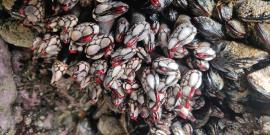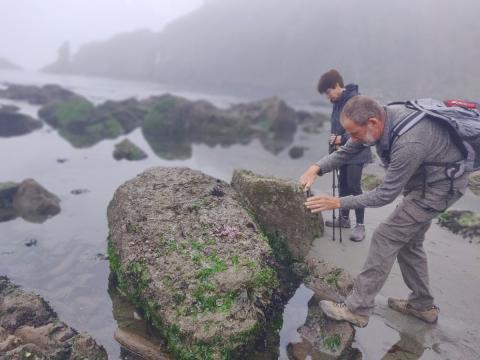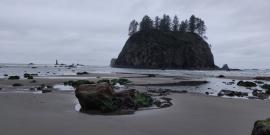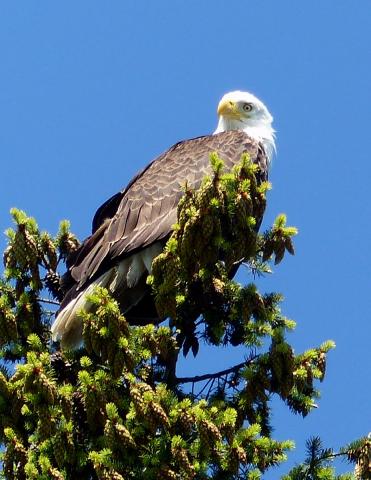
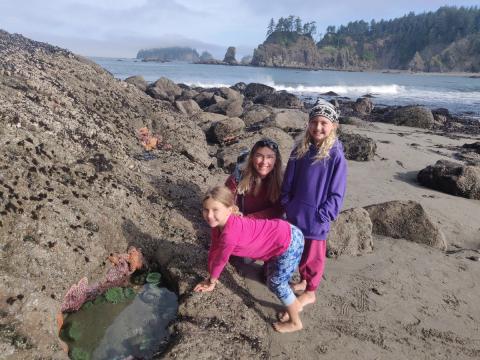
Search for Sea Stars with Experience Olympic
The Pacific Coast in Olympic National Park is amazing for hiking, tidepooling, and birding from April to September. Coastal hikes in August are sublime as you are often enveloped in fog and mushrooms spring up everywhere.
Private guided tidepooling tours can be scheduled as half day tours from Forks (where Carolyn meets you in Forks M-F at 7:15 AM) or Port Angeles if the tide is low enough.
Visiting the the Coast is best enjoyed with a guide because she will get you there at low tide and we can look at Sea Otters, Harbor Seals, and Bald Eagles in her spotting scope.
Great for hiking, tidepooling, and birding
A full day guided hiking tour can be organized to explore this coastline for those who are physically fit and eager for some climbing and descents on stairs, ladders, and ropes.
In addition to wilderness beaches, you will also experience wild headlands, rocky islets, giant beach logs, and tidepools for tidepooling if visiting during a low tide.
These same features also create a good birding tour destination. Larger offshore islands are full of breeding birds during the summer.
The Olympic National Park coastline is a unique wilderness experience
The Olympic National Park’s wilderness coastline stretches for 62 miles (100 km), creating the longest undeveloped coastline in the continental United States.
Adjacent to this wild and rugged coastline, the Olympic Coast National Marine Sanctuary includes thousands of offshore nautical miles.
Olympic National Park's dynamic coastal wilderness includes rocky features like caves and huge beach logs indicative of ceaseless wave action and intense winter storms.
Marine Wildlife, Plant, and Seaweed Diversity
Even if you are unable to visit during a low tide event, there is still an opportunity to enjoy what is "under the sea" with use of a spotting scope and binoculars.
Also, you never know what the waves will wash ashore. While walking the beach, we have enjoyed fish spawning events, peregrine falcon hunts, all manner of dead marine mammals (including whales), invertebrate molts, fresh kelp and seaweed, sea jellies, dead squid, sand dollars, and so much more.
Sea Otter vs. River Otter
Both sea and river otter live near Olympic National park coastal beaches. Both are mustelids (weasel family) and swim in the water.
Sea Otters are large mammals with light brown faces and have webbed back feet. Movement on land is difficult for Sea Otters, whereas River Otters have back paws and are often observed running on land.
Sea otters float on their backs, which is not something common for River Otter. Pictured are a group of Sea Otters.
Birds in Marine Environments
Tufted Puffin is a bird that everyone can get excited about though usually you need a spotting scope in order to see them well. During the summer, they breed on offshore islands and can be seen from shore hunting or flying around.
Bald Eagle is another common bird that is seen in coastal environments, especially near marinas where they often get fish remains. They nest close to the water in mature conifer trees that have decadence (dead, broken or deformed tops and/or bole or root rot) for nest building.
If you are interested in organizing a tour specifically for bird watching, check out our birding tours.

Olympic National Park's Beach Logs
Beach logs are a unique feature of the Olympic National Park beaches and the Washington coastline. These giant dead trees connect us to the living ancient forests in the interior of the park.
Giant eroded trees travel down the Sol Duc, Calawah, Bogachiel (these three rivers come together to form the Quillayute River) and the Hoh Rivers and then out into the ocean.
The root wads of these trees often decompose at a slower rate and create amazing natural wonders on the beach.
Olympic Peninsula plate tectonics
The geology of the Olympic Peninsula is well documented in the strata observed on the coastline. The subduction of the Juan de Fuca Plate under the North American Plate has resulted in the distinct topography found on the Olympic Peninsula.
The Olympic Peninsula is part of a leading edge coast, which results in a characteristically short distance between the coastline and the Olympic Mountains, creating a variety of ecosystems and biodiversity within this steep gradient.
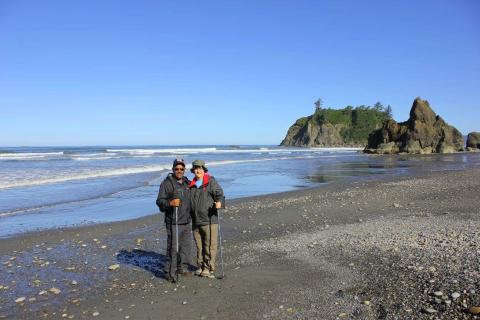
Wild Olympic Beaches can be Dangerous
Our beaches are not for swimming, boating, or exploring without knowledge, respect, and experience with cold water, the tide cycle, and storms.
The weather outside is not always indicative of weather in the ocean. Waves are caused by local wind, whereas swells are caused by storm winds that can be hundreds of miles out to sea.
Tide predictions are just that, predictions of what waves will be like under normal weather conditions that do not take storms and swells into account.
Olympic National Park Coastal Forest
You can drive up to some Olympic National Park Beaches, whereas others you have to hike a short distance through coastal forest in order to access the beach.
Coastal Forests that are currently within Olympic National Park have been impacted by early 20th century logging practices. The forest soils are largely intact due to lack of heavy machinery and because giant stumps of selectively logged (mostly Western Red Cedar) were left behind.
Coastal forests are often cloaked in fog and are dominated by Sitka Spruce and Western Hemlock.
